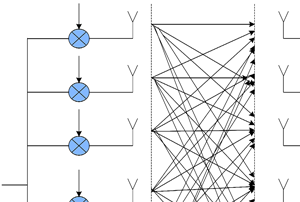Performance of multiple antenna beamforming in higher constellation PSK signaling schemes
DOI:
https://doi.org/10.3103/S0735272720020065Keywords:
beamforming, offset, multiple antenna, weigh, Rayleigh, consellation, signaling schemeAbstract
The quality of reception of radio signals at the destination is greatly influenced by the type of signaling schemes used and the use of multiple antennas at the output of transmitter and the input of receiver. However, this configuration usually causes InterCarrier Interference (ICI), which leads to distortions. In this paper, the performance of 6×6 multiple antenna beamforming in offset 16, 32 and 64-Phase Shift Keying (PSK) schemes is evaluated using the system model for the received signal developed to reduce distortions. The beamforming is performed on the offset signaling schemes by weighing the transmitted streams with the eigenvalues of the 6×6 antenna channel before the transmission through the 6 multiple antennas over the Rayleigh channel. The distorted signals received are demodulated and filtered by using the square root raised cosine receive filter. These signals are detected and compared with the transmitted bits to evaluate the performance using Bit Error Rate (BER). The results obtained show that as the constellation size of offset PSK schemes increases, the BER values increase and provide better performance than the corresponding conventional schemes.References
- Z. K. Adeyemo and I. A. Ojedokun, “EGC receiver using single radio frequency chain and single matched filter over combined Rayleigh and Rician fading channels,” ARPN J. Eng. Appl. Sci., vol. 9, no. 7, pp. 992–998, 2014. URL: https://www.researchgate.net/publication/290176849_Egc_receiver_using_single_radio_frequency_chain_and_single_matched_filter_over_combined_Rayleigh_and_Rician_fading_channels.
- A. Goldsmith, Wireless Communications. Cambridge University Press, 2005.
- H. S. Jochen, Mobile Communication. Massachusetts: Longman Publishing Company, Reading, 2000.
- Y. S. Cho, J. Kim, W. Y. Yang, and C. G. Kang, MIMO-OFDM Wireless Communications with MATLAB®. Chichester, UK: John Wiley and Sons, 2010.
- T. Weber, A. Sklavos, and M. Meurer, “Imperfect channel-state information in MIMO transmission,” IEEE Trans. Commun., vol. 54, no. 3, pp. 543–552, Mar. 2006, doi: https://doi.org/10.1109/TCOMM.2006.869783.
- G. G. Raleigh and J. M. Cioffi, “Spatio-temporal coding for wireless communication,” IEEE Trans. Commun., vol. 46, no. 3, pp. 357–366, 1998, doi: https://doi.org/10.1109/26.662641.
- G. J. Foschini and M. J. Gans, “On Limits of Wireless Communications in a Fading Environment when Using Multiple Antennas,” Wirel. Pers. Commun., vol. 6, no. 3, pp. 311–335, 1998, doi: https://doi.org/10.1023/A:1008889222784.
- A. Gorokhov, D. A. Gore, and A. J. Paulraj, “Receive antenna selection for MIMO spatial multiplexing: Theory and algorithms,” IEEE Trans. Signal Process., vol. 51, no. 11, pp. 2796–2807, Nov. 2003, doi: https://doi.org/10.1109/TSP.2003.818204.
- B. A. Cetiner, E. Akay, E. Sengul, and E. Ayanoglu, “A MIMO system equipped with multifunctional reconfigurable antennas,” in IEEE Antennas and Propagation Society, AP-S International Symposium (Digest), 2006, pp. 157–160, doi: https://doi.org/10.1109/APS.2006.1710477.
- C. N. Chuah, D. N. C. Tse, J. M. Kahn, and R. A. Valenzuela, “Capacity scaling in MIMO wireless systems under correlated fading,” IEEE Trans. Inf. Theory, vol. 48, no. 3, pp. 637–650, Mar. 2002, doi: https://doi.org/10.1109/18.985982.
- D. Tse and P. Viswanath, Fundamentals of Wireless Communication. Cambridge University Press, 2005.
- M. Gheryani, Z. Wu, and Y. R. Shayan, “Capacity and performance of adaptive MIMO system based on beam-nulling,” in IEEE International Conference on Communications, 2009, doi: https://doi.org/10.1109/ICC.2009.5198804.
- Z. K. Adeyemo, E. O. Rabiu, and O. A. Robert, “Offset Phase Shift Keying Modulation in Multiple-Input Multiple-Output Spatial Multiplexing,” Trans. Networks Commun., vol. 3, no. 2, pp. 116–116, Apr. 2015, doi: https://doi.org/10.14738/tnc.32.1144.
- J. G. Proakis and M. Salehi, Communication Systems Engineering. New Jersey: Prentice Hall, 2002.
- J. Proakis and M. Salehi, Digital Communications, 5th ed. New York: McGraw-Hill Science/Engineering/Math, 2007.
- T. S. Rappaport, Wireless Comunications - Principles and Practice, 2nd ed. New Jersey: Prentice Hall, 2002.
- B. Sklar, Digital Communications: Fundamentals and Applications. New Jersey: Prentice-Hall PTR, 2001.
- A. Amin, “Computation of bit-error rate of coherent and non-coherent detection M-ary PSK with gray code in BFWA systems,” Int. J. Adv. Comput. Technol., vol. 3, no. 1, pp. 118–126, 2011, doi: https://doi.org/10.4156/ijact.vol3.issue1.13.
- K. S. Ahn, R. W. Heath, and H. K. Baik, “Shannon capacity and symbol error rate of space-time block codes in MIMO rayleigh channels with channel estimation error,” IEEE Trans. Wirel. Commun., vol. 7, no. 1, pp. 324–333, Jan. 2008, doi: https://doi.org/10.1109/TWC.2008.060539.
- A.. Mindaudu, “BER Performance of MPSK and MQAM in 2x2 Almouti MIMO Systems,” Int. J. Inf. Sci. Tech., vol. 2, no. 5, pp. 1–10, Sep. 2012, doi: https://doi.org/10.5121/ijist.2012.2501.
- H. Liu, “Error Performance of MIMO Systems in Frequency Selective Rayleigh Fading Channels,” in Conference Record / IEEE Global Telecommunications Conference, 2003, vol. 4, pp. 2104–2108, doi: https://doi.org/10.1109/glocom.2003.1258607.
- C. Li and X. Wang, “Performance comparisons of MIMO techniques with application to WCDMA systems,” EURASIP J. Appl. Signal Processing, vol. 2004, no. 5, pp. 649–661, May 2004, doi: https://doi.org/10.1155/S1110865704309029.
- G. Taricco, “Asymptotic mutual information statistics of separately correlated Rician fading MIMO channels,” IEEE Trans. Inf. Theory, vol. 54, no. 8, pp. 3490–3504, Aug. 2008, doi: https://doi.org/10.1109/TIT.2008.926415.
- H. H. Chen, Y. C. Yeh, M. Guizani, and Y. M. Huang, “Space-time complementary coding MIMO with joint spatial diversity and multiplex capability,” IEEE Trans. Wirel. Commun., vol. 7, no. 8, pp. 2950–2956, Aug. 2008, doi: https://doi.org/10.1109/TWC.2008.060551.
- E. A. Jorswieck and H. Boche, “Performance analysis of capacity of MIMO systems under multiuser interference based on worst-case noise behavior,” EURASIP J. Wirel. Commun. Netw., vol. 2004, no. 2, pp. 273–285, Dec. 2004, doi: https://doi.org/10.1155/s1687147204406136.

Downloads
Published
2020-03-28
Issue
Section
Research Articles

